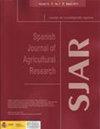Use of B–mode and Power Doppler ultrasonography of the uterus and preovulatory follicle to predict ovulation time in Holstein cows after heat synchronization
IF 0.8
4区 农林科学
Q3 AGRICULTURE, MULTIDISCIPLINARY
引用次数: 0
Abstract
Aim of study: To evaluate the utility of B-mode and Power Doppler ultrasonography to predict ovulation time in Holstein cows by assessment of uterine and follicle measurements. Area of study: Galicia, NW Spain Material and methods: 33 Holstein cows were examined every 12 h until ovulation. Measurements for the ratio endometrium/myometrium (END/MYO), uterine lumen (UL), diameter of the dominant follicle (DF), and Power Doppler of the dominant follicle and corpus luteum were recorded. The times of onset of heat, maximum heat (MHA) and heat finalization were obtained from the database of monitoring devices. Blood samples were taken at each examination for progesterone (P4) determination. Data were analyzed using one-way ANOVA and Pearson’s χ2 tests. Main results: For UL, time -6 (1.53 mm) with respect to ovulation (time 0) significantly differed from time -42 (5.70 mm). Concerning DF, significant differences were observed between time -6 (20.48 mm) and time -54 (16.60 mm). As for P4, significant differences were found between time -6 (0.34 ng/mL) and time -54 (1.03 ng/mL). Considering MHA, significant differences were observed for the UL between after and before/during groups; for DF, significant differences were found before and after MHA. As for heat, the UL significantly differed between after and before/during groups. Significant differences were found for the percentage of cows with Doppler signal in the ovulatory follicle and corpus luteum concerning MHA and heat factors. Research highlights: The use of Power Doppler to predict ovulation time needs to be refined. The END/MYO and UL measurements could be useful to identify cows in heat, but inaccurate to determine ovulation.使用子宫和排卵前卵泡的 B 型和动力多普勒超声波检查预测荷斯坦奶牛同步发情后的排卵时间
研究目的通过评估子宫和卵泡的测量值,评估 B 型超声波和动力多普勒超声波预测荷斯坦奶牛排卵时间的实用性。 研究地区:西班牙西北部加利西亚材料与方法:33 头荷斯坦奶牛每隔 12 小时接受一次检查,直至排卵。记录子宫内膜/子宫肌层比率(END/MYO)、子宫腔(UL)、优势卵泡直径(DF)以及优势卵泡和黄体的功率多普勒测量值。发情时间、最高发情时间(MHA)和最终发情时间均从监测设备数据库中获取。每次检查均抽取血液样本用于测定孕酮(P4)。数据分析采用单因素方差分析和 Pearson's χ2 检验。 主要结果就 UL 而言,排卵(时间 0)的时间 -6 (1.53 mm)与时间 -42 (5.70 mm)存在显著差异。在 DF 方面,观察到排卵时间-6(20.48 毫米)与排卵时间-54(16.60 毫米)之间存在显著差异。至于 P4,第 -6 次(0.34 纳克/毫升)和第 -54 次(1.03 纳克/毫升)之间存在显著差异。就 MHA 而言,UL 在之后和之前/期间组之间存在显著差异;DF 在 MHA 之前和之后存在显著差异。至于加热,加热后组和加热前/加热中组之间的超限值存在显著差异。在MHA和发情因素方面,排卵卵泡和黄体出现多普勒信号的奶牛比例存在显著差异。 研究亮点:使用动力多普勒预测排卵时间有待改进。END/MYO和UL测量值可用于识别发情奶牛,但在确定排卵方面并不准确。
本文章由计算机程序翻译,如有差异,请以英文原文为准。
求助全文
约1分钟内获得全文
求助全文
来源期刊

Spanish Journal of Agricultural Research
农林科学-农业综合
CiteScore
2.00
自引率
0.00%
发文量
60
审稿时长
6 months
期刊介绍:
The Spanish Journal of Agricultural Research (SJAR) is a quarterly international journal that accepts research articles, reviews and short communications of content related to agriculture. Research articles and short communications must report original work not previously published in any language and not under consideration for publication elsewhere.
The main aim of SJAR is to publish papers that report research findings on the following topics: agricultural economics; agricultural engineering; agricultural environment and ecology; animal breeding, genetics and reproduction; animal health and welfare; animal production; plant breeding, genetics and genetic resources; plant physiology; plant production (field and horticultural crops); plant protection; soil science; and water management.
 求助内容:
求助内容: 应助结果提醒方式:
应助结果提醒方式:


